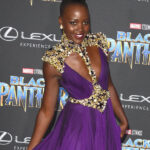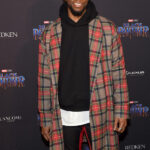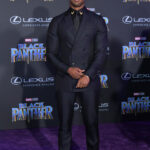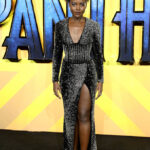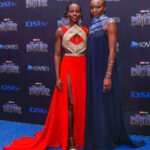In the past several weeks, I have been following closely the press tour for Marvel’s smash hit, Black Panther. A highly anticipated adaptation of the comic books, Black Panther joyously takes its viewers on an astonishingly creative and moving journey of the protagonist, King T’Challa. The sovereign of the fictional nation of Wakanda, a hidden African country both rich and advanced, T’Challa rules a nation of people who have never been colonized. In terms of both politics and fashion, the lack of colonization is a very important theme. The costumes Ruth E. Carter created for the movie walk in a distinctly Afro-futuristic path in which traditional African fashions meet technological advancement with a colorful, sleek result. The importance of African influences, therefore, traversed beyond the movie and into its promotional strategy. In this post, I would like to discuss the extraordinary meeting between Hollywood sartorial traditions, the culture of superhero franchises, and race politics in the press tour for Black Panther.
In the past decade or so, promotion for Hollywood movies with large budgets (mostly superhero movies) has been characterized in three ways: recognition, location, and fashion. Firstly, the recognition comes with the presence of the leading actors (and sometimes the director, if they’re well known) in both press junkets, premieres, and additional promotions (TV ads, online content, product endorsements). Secondly, the locations of the promotion vary in a rapid pace: the actors are often taken on a whirlwind tour in which they promote the movie in a different city every other day or so for two weeks at the most. They often fly to different continents, adjust to different cultures, and speak different languages (if they are able). This is done in order to localize the promotion of the movie for audiences who are not necessarily attuned to American entertainment. Thirdly, the fashion of the promotional tours follows a strict code: upgraded casualwear for press calls, bespoke couture for premiers. Unsurprisingly, the appearance of actresses is scrutinized much more closely than actors in those occasions. Equally unsurprising is the studio budgeting of stylists and hair/make-up artists specifically for this purpose.
The press tour for Black Panther has been, in many ways, a standard big budget movie press tour, with one notable exception: the importance it placed on fashion, and the close collaboration Marvel Studios had with the fashion world. Far from the traditional gowns and tuxedos, the brief for the Los Angeles world premiere of the movie seemed to be “royal attire.” There were no tiaras or ermine capes in sight; instead, many of the black celebrities in attendance dressed to emulate either their native lands, or African heritage. Several others, including much of the leading cast, chose to wear clothes by Western fashion houses which either reference African cultural influences, or were paired with African-inspired accessories. Lupita Nyong’o, for instance, wore a custom Atelier Versace dress which evoked militaristic themes together with traditional eveningwear, paired with traditional Yoruba hairstyle. Chadwick Boseman wore an Emporio Armani fall 2018 ensemble which paired a flowery heavy-silk double-breasted jacket with pleated pants, pairing gold and black for royalty, and flowers for an untraditional take on the tuxedo jacket.
The meeting between Afro-futurism and Western fashion continued on other occasions as well, during which the leading cast wore ensembles by Givenchy, Calvin Klein, and Balmain, among others. All ensembles had either an African-inspired motif or were paired with African-inspired accessories and/or hairstyles. The meeting between the promotion for Black Panther and the fashion world continued past the premieres into a collaboration between Marvel Studios and New York Fashion Week. In a February 12th showcase named “Welcome to Wakanda,” ten fashion designers or houses exhibited custom looks designed with Black Panther in mind. The leading cast once again assembled, wearing interesting interpretations of the costumes worn by their characters. Notably, the color story of their clothes was earth tones. Chadwick Boseman even wore a black hoodie, perhaps as a nod to his character’s black superhero suit, perhaps as a salute to the Black Lives Matter movement.
The politicization of the Black Panther press tour, particularly when it comes to combining the semiotics of black power, fashion innovation, and Hollywood image management has been fascinating to observe. This movie, with its all-black leading cast, championing not only black excellence but also African traditions, has already made an indelible cultural impact. It is important to note that major fashion houses have not been known to offer their wares (especially couture runway looks and custom creations) to major black actors perhaps until this decade. That Chadwick Boseman, Danai Gurira, Michael B. Jordan, and Lupita Nyong’o have all repeatedly worn couture, sometimes with them specifically in mind, is nothing less than groundbreaking. On a last note, the immediate impact of Black Panther’s sartorial flare has been notable even when it comes to its audience: many black audience members chose to dress up, in order to emulate their cultures and traditions for the opening weekend of the film, both in the United States and in Africa. This is virtually unheard of, even in superhero culture, where audience members often dress to emulate their favorite heroes for screenings. The long-term implications of Black Panther as a cultural marker are still unknown, but they are surely substantial, as can already be seen.
- Lupita Nyong’o in Atelier Versace and a traditional Yoruba hairstyle
- Chadwick Boseman in Emporio Armani Spring 2018 ensemble for the Black Panther world premiere
- Chadwick Boseman in Fear of God
- Chadwick Boseman in Givenchy Couture
- Lupita Nyong’o in Atelier Versace, Winston Duke in Etro, and Danai Gurira in Gabriela Hearst at Oscars 2018
- Daniel Kaluuya in a kanzu
- Michael B. Jordan in Calvin Klein
- Chadwick Boseman in Givenchy
- Lupita Nyong’o in Balmain
- Lupita Nyong’o in Kevin Mayes and Danai Gurira in The Row
